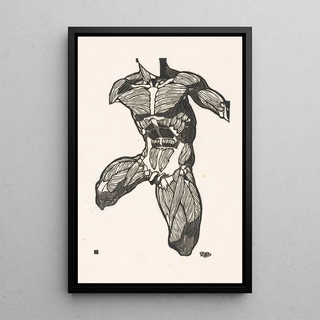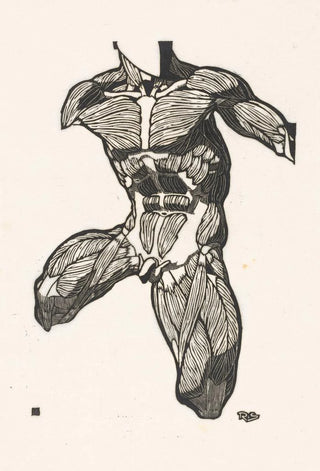Art print | Anatomical study of the muscles of the neck, abdomen, and thigh of a man - Reijer Stolk


View from behind

Frame (optional)
Anatomical study of the muscles of the neck, abdomen, and thigh of a man: a fascinating exploration of the human body
The artwork "Anatomical study of the muscles of the neck, abdomen, and thigh of a man" by Reijer Stolk stands out for its precision and attention to detail. The delicate lines and subtle shadows reveal an in-depth understanding of human anatomy. The colors, although primarily monochrome, evoke a sense of depth and realism, allowing the viewer to appreciate the complexity of muscular forms. This art print invites attentive contemplation, where each muscle seems to come to life, demonstrating the artist's exceptional craftsmanship.
Reijer Stolk: a pioneer of artistic anatomy
Reijer Stolk, active in the 17th century, is recognized for his contributions to anatomical art, a field flourishing in his time. Influenced by the scientific advances of the Renaissance, Stolk successfully combined art and science, making his studies not only precise but also aesthetically pleasing. His work is part of a tradition where meticulous observation of the human body is essential, and he captured details often overlooked by other artists. The importance of Stolk lies in his ability to elevate anatomical study to the level of art, thereby influencing many artists and scientists who followed.
A decorative acquisition with multiple advantages
The reproduction of the artwork "Anatomical study of the muscles of the neck, abdomen, and thigh of a man" is an ideal decorative choice for various spaces, whether in a living room, office, or bedroom. Its print quality and fidelity to the original details make it a captivating art print that draws the eye and sparks conversations. The aesthetic appeal of this canvas lies in its ability to blend art and science, offering an intellectual dimension to your interior decoration. By incorporating this art print into your space, you add a touch of elegance and curiosity, while celebrating the artistic heritage of anatomy.

Matte finish

View from behind

Frame (optional)
Anatomical study of the muscles of the neck, abdomen, and thigh of a man: a fascinating exploration of the human body
The artwork "Anatomical study of the muscles of the neck, abdomen, and thigh of a man" by Reijer Stolk stands out for its precision and attention to detail. The delicate lines and subtle shadows reveal an in-depth understanding of human anatomy. The colors, although primarily monochrome, evoke a sense of depth and realism, allowing the viewer to appreciate the complexity of muscular forms. This art print invites attentive contemplation, where each muscle seems to come to life, demonstrating the artist's exceptional craftsmanship.
Reijer Stolk: a pioneer of artistic anatomy
Reijer Stolk, active in the 17th century, is recognized for his contributions to anatomical art, a field flourishing in his time. Influenced by the scientific advances of the Renaissance, Stolk successfully combined art and science, making his studies not only precise but also aesthetically pleasing. His work is part of a tradition where meticulous observation of the human body is essential, and he captured details often overlooked by other artists. The importance of Stolk lies in his ability to elevate anatomical study to the level of art, thereby influencing many artists and scientists who followed.
A decorative acquisition with multiple advantages
The reproduction of the artwork "Anatomical study of the muscles of the neck, abdomen, and thigh of a man" is an ideal decorative choice for various spaces, whether in a living room, office, or bedroom. Its print quality and fidelity to the original details make it a captivating art print that draws the eye and sparks conversations. The aesthetic appeal of this canvas lies in its ability to blend art and science, offering an intellectual dimension to your interior decoration. By incorporating this art print into your space, you add a touch of elegance and curiosity, while celebrating the artistic heritage of anatomy.






